Mamelodi Sundowns have built a reputation as one of the best football sides in Africa.
With their unique and attractive style of play, coined: ‘Shoeshine and piano’ — a style of play not too dissimilar in certain aspects or others to the distinct styles you might see on offer at some of Europe’s most attractive clubs, such as EPL side Manchester City, Ligue 1’s Marseille or La Liga’s Barcelona, that will only grow in admiration the more it gets promoted — they have won each of the last four South African Premier Soccer League titles, boosting their grand total of PSL titles to 11, the most of any side in PSL history.
Furthermore, ‘The Brazilians’, as they’re affectionately known, currently sit at the top of the table for the 2021/22 campaign by some distance and look like they are adding a 12th PSL title to their impressive record.
Sundowns are also one of just two South African teams to have won the CAF Champions League, along with Orlando Pirates, who won the competition in 1995, doing so more recently than their compatriots, in 2016 under the elite leadership of coach Pitso Mosimane, who enjoyed a successful eight-year reign in charge of Sundowns and is now a three-time CAF Champions League winner, having guided the most successful club in world football in terms of trophies won, Egypt’s Al Ahly, to the last two CAF Champions League titles.
Following Mosimane’s departure in 2020, Sundowns opted for a unique approach to replacing the highly successful manager.
Steve Komphela became the first-team senior coach, with Manqoba Mngqithi and Rulani Mokwena assuming joint-head coach duties for the Pretoria-based club.
The high-quality, experience-packed coaching setup successfully guided the Brazilians to a fourth-straight PSL title last season and looks on course to achieve the same league finish this term.
CAF glory is also no doubt one of Sundowns’ ambitions.
In this tactical analysis and team-focused scout report, I’ll aim to provide some analysis of how Sundowns’ coaching setup has got the team playing this season.
I’ll analyse the latest iteration of The Brazilians’ Shoeshine and piano-playing philosophy by exploring some key talking points regarding the PSL leaders’ strategy and tactics in 2021/22 thus far.
I hope that this tactical analysis gives readers a clear idea of Sundowns’ entertaining and efficient playing style and convinces some to turn their eye to one or two of the South African side’s games this season to take in what is surely one of world football’s most stylistically exciting sides to watch at present.
Build-up play
To kick off this tactical analysis, I’ll examine how the current Sundowns side is set up during the build-up phase of play.
Firstly, while they were mainly deployed in a 4-3-3 shape last season, Sundowns have mostly played in a 4-4-2/4-2-3-1 shape this term.
Without possession, Sundowns’ shape typically looks like a 4-4-2, but with possession, They often line up in more of a 4-2-2-2 shape, with the wingers tucking in just behind the strikers and in front of the holding midfield duo.
The Brazilians are a heavily possession-based side, having kept the highest amount of possession (62%) in South Africa’s top flight in 2021/22.
The second-most possession-based side has kept just under 8% less of the ball than Sundowns this season, highlighting just how dominant the Brazilians are in terms of keeping the ball.
Part of this is due to their tactics with the ball, while part of it is also naturally a result of their tactics without the ball, as we’ll discuss later in this tactical analysis.
For now, though, we’ll focus solely on Sundowns’ approach to the ball, in particular, what they aim to do in the first phase of possession—the build-up phase—in this section of analysis.
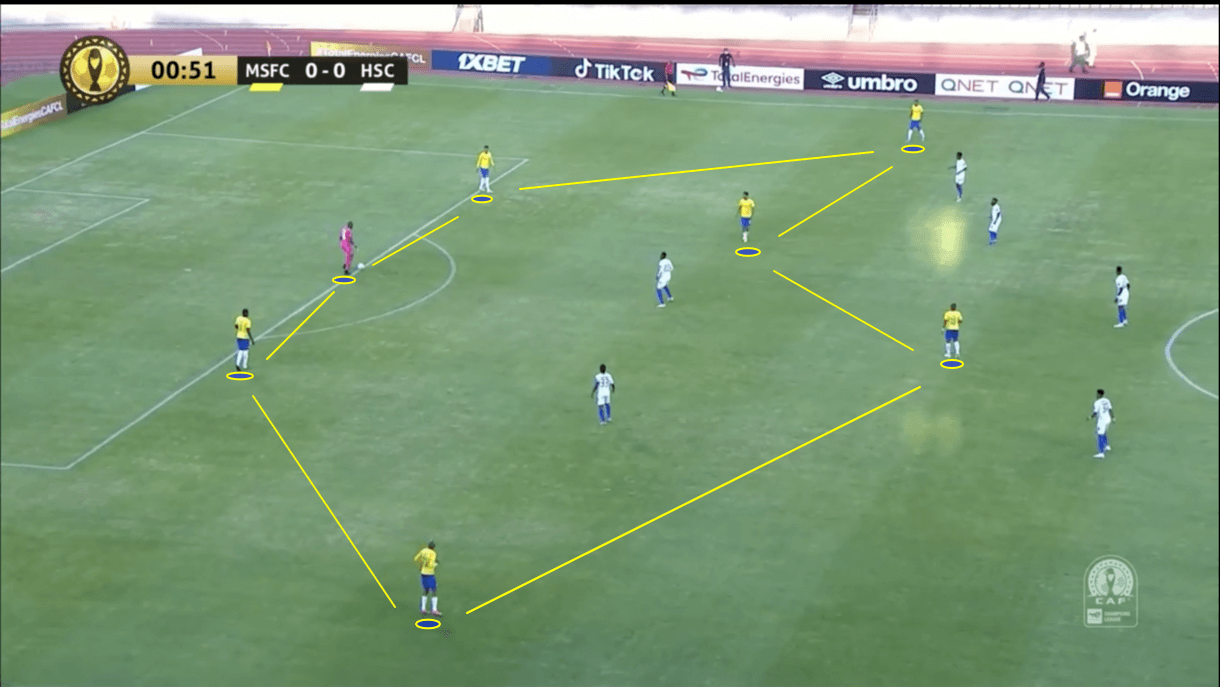
As depicted in Figure 1, Sundowns’ centre-backs tend to split quite wide in the build-up phase, while the full-backs push themselves high, situating themselves on the next line on either side of the holding-midfield duo.
The holding midfielders generally try to take up staggered positions, essentially meaning that they look to avoid standing right next to each other, which creates more passing angles for the goalkeeper and centre-backs in the first line and makes it harder for the opposition to mark and prevent Sundowns from progressing through them than they would be if just standing next to each other to create a flat four-man line in front of the two centre-backs and ‘keeper, who, as seen in figure 1, is given licence to advance into the space between the centre-backs if necessary to create a +1 advantage over the opposition’s forwards if they’re pressing with a two-man frontline.
This +1 advantage helps Sundowns to break the opposition’s first line of pressure and progress into midfield, as does the staggered midfielders and the high positioning from the full-backs.
Everything about Sundowns’ play, at this point, is geared towards breaking the first line of pressure and getting the ball into central midfield.
In general, The Brazilians are a patient team that likes to draw pressure from opposition players in deep areas by playing short passes between players in the first and second lines until a clear opportunity for progression presents itself.
Along with their general ball-dominant nature, this is one of the key tactical factors that’s led to Sundowns making the most passes (461.49 per 90) of any PSL side this term and maintaining the best pass success rate (86.1%) in the process.
They’re careful and patient in the build-up as they search for a clear opportunity for progression while deploying players of good technical prowess to execute the coaches’ instructions to a high standard.
Ideally, they’ll create an opening to get the ball from the first line into one of the two holding midfielders who’ll then look to turn and send the ball forward once again, this time to one of the four-man ‘2-2’ shaped forward line, some of whom will be looking to exploit space between the lines and some of whom will be aiming to exploit space behind the opposition backline.
The wingers and forwards, ahead of the holding midfielders, must then demonstrate good movement and spatial awareness.
It’s common to see forwards dropping deeper and wingers advancing into higher areas to exploit space that subsequently opens as a result of the forwards’ movements as Sundowns aim to progress into the final third.
This movement is essential for pulling opposition defenders out of position and creating space that can be exploited as their team looks to enter the final third.
The combination of the attackers’ movement, along with the midfielders’ vision and technical passing quality, is then crucial for Sundowns as they look to exploit space, progress upfield, and enter the final third.
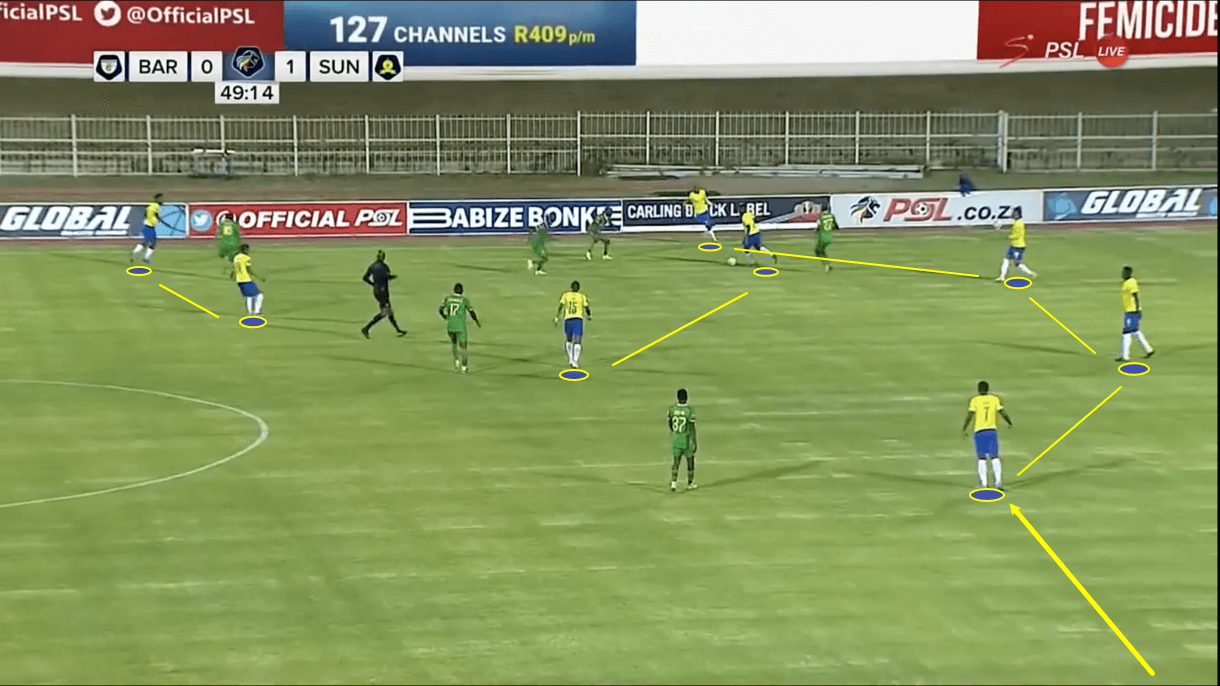
If they are unable to progress into midfield via one of the centre-backs or goalkeepers, we may see Sundowns look to break into central midfield via the wide, high full-backs.
This was the case in the passage of play shown in Figure 2.
It’s worth noting that in possession, Sundowns generally try to retain quite a narrow shape.
The 4-2-2-2 facilitates this as it is, by nature, quite narrow.
However, in Figure 2, we also see how the spacing between players, such as the left back and left centre-back, is kept pretty tight.
When the ball is positioned on the right flank in the build-up, the entire team shape will move over towards the right, with only the left-back positioned on the left half of the pitch in Figure 2 — and just about, at that.
The ball-far full-back doesn’t position himself wide, hugging the touchline at all times as many full-backs/wing-backs do.
Instead, he’ll come inside to keep the overall shape narrow, creating another potential short passing option in the centre to help Sundowns achieve their primary goal in this stage of play: to find a clear path of progression through the centre of the pitch.
The benefit of this doesn’t just lie in achieving their goal of central progression, however — it’s two-fold, in fact, as the ball-far full-back’s narrow positioning to retain a narrow, compact shape helps Sundowns to guard against the potentially harmful impact of a deep turnover.
Because of the team’s narrow, compact shape, they make life more difficult for the opposition should a turnover occur when playing their short passing game in the build-up and increase their chances of regaining possession quickly by counter-pressing after a turnover.
This is another important element of the Brazilians’ tactics that helps them perform formidably in transition to defence and be a tougher side to break down in general.
That said, their quality on the ball and narrow shape, which creates many short passing options, help them keep the ball better and prevent many deep turnovers from occurring in the first place anyway.
This narrow, compact shape is an excellent precaution in case of a turnover as well, however.
While Sundowns are the most pass-heavy side in the PSL, they’ve also played the fewest long balls (36.65 per 90) this term.
They don’t aim to play very many long balls, which is why they don’t place ball-far wingers and full-backs far away on the opposite sideline in the build-up phase.
As Figure 2 shows, they prefer to have more short passing options by positioning more players close by in central positions.
Entering the final third
The full-backs’ roles are, once again, worth noting as Sundowns move from the build-up to the progression phase and chance creation phase.
Again, right at the beginning of the build-up, we see the full-backs push high to either side of the two holding midfielders, as shown in Figure 1.
As The Brazilians enter midfield via the centre-backs or goalkeeper, the midfielders are typically required, where possible, to take the ball on the half-turn and pick out a teammate in the following line ahead.
In this regard, Sundowns are a very aggressive team in terms of ball progression after passing the opposition’s first line of pressure and like to move vertically through the lines as efficiently as possible while picking out clear short passing options and adhering to their philosophy of playing shorter passes rather than less controlled long balls.
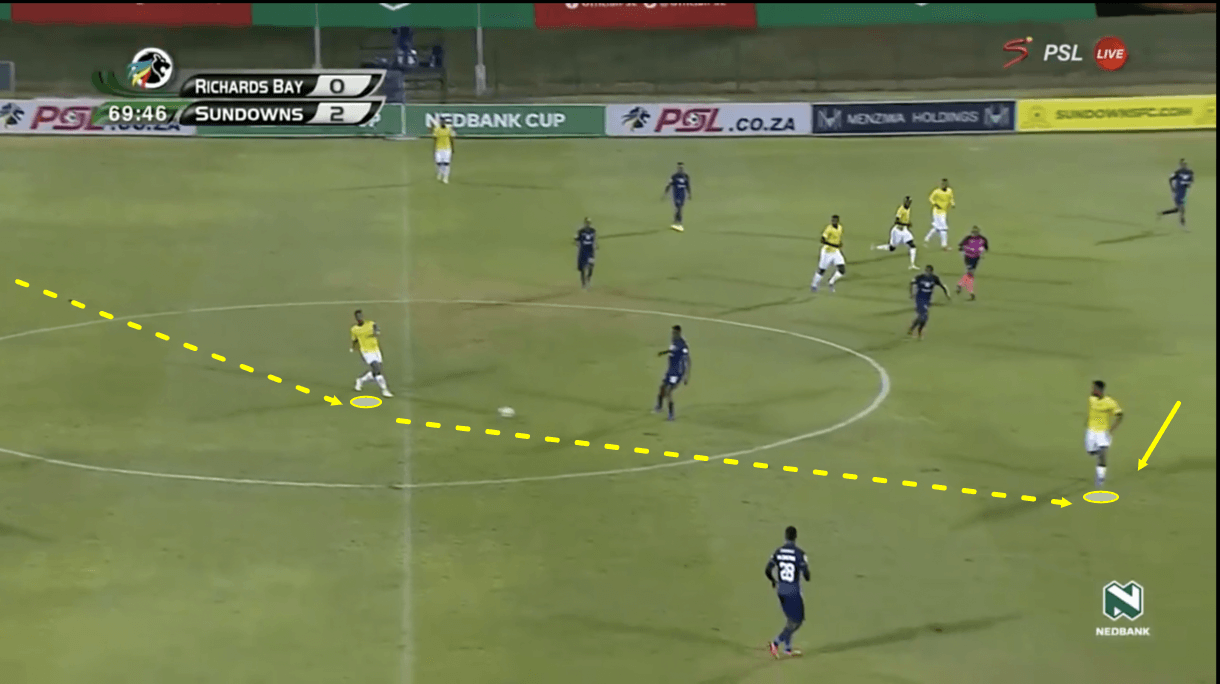
Just before Figure 3, we saw Sundowns’ holding midfielder receive a pass from a centre-back behind the opposition’s first line of pressure.
On receiving, and having scanned profusely at the correct times before getting on the ball, the midfielder turned, spotted the right-winger moving out of the opposition midfielder’s cover shadow in the right half-space and sent the ball forward, finding the playmaker between the lines.
This passage of play provides an excellent example of Sundowns’ vertical yet careful progressive passing philosophy in action.
The holding midfielder is required to quickly display excellent technical and mental ability on the ball to receive, turn, pick a pass, and execute with enough quality to get beyond the opposition’s next line and into a teammate’s feet, which he achieves here.
This is the kind of action we see Sundowns’ midfielders constantly pulling off in-game, which is a testament to their quality and the Sundowns coaching team’s ability on the training ground to adequately prepare the players to execute their plans to a high standard — this is on display in figure 3 both from the deep-lying midfielder and the winger who demonstrated excellent vision and movement to find space behind the opposition’s midfield and receive the deep midfielder’s progressive pass.
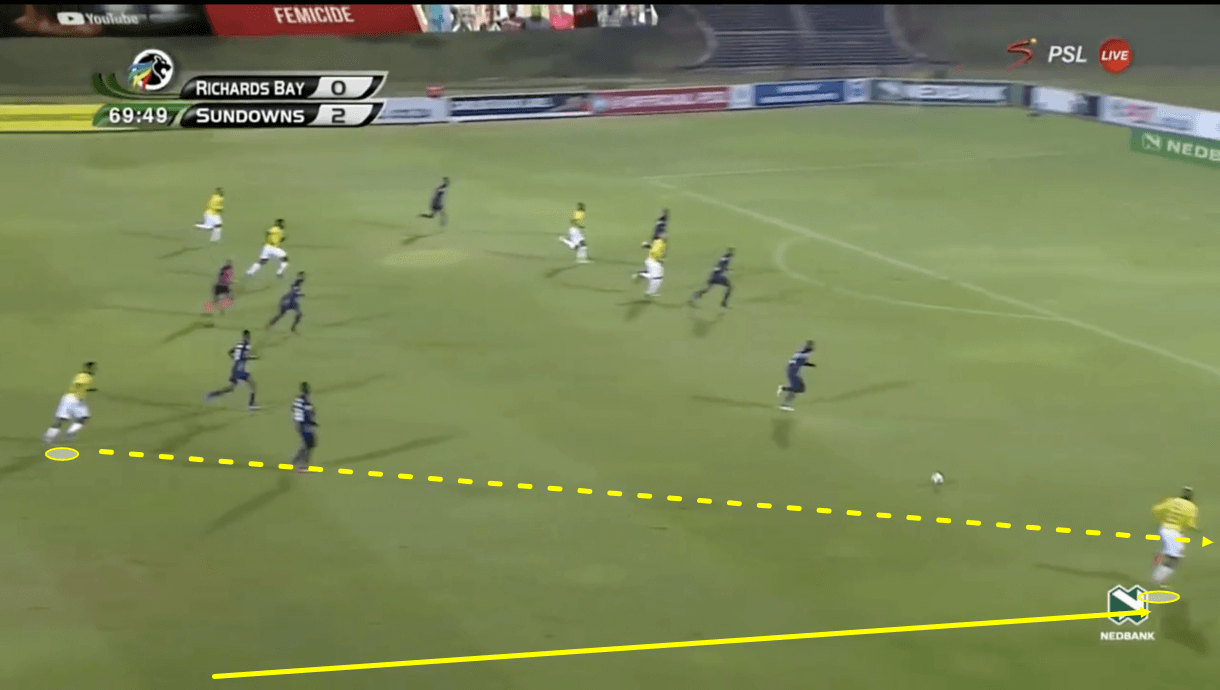
As play moves on into Figure 4, we see how the winger acted similarly to the holding midfielder, again demonstrating an excellent example of the kind of action Sundowns’ coaches love to see their players make—receive on the half-turn, pick out a player running into space on the next line, and execute with enough technical quality to turn the vision into reality.
On this occasion, we see the right winger play a well-weighted through ball into the running path of the overlapping right back, who progressed upfield after the centre-back initially found the holding midfielder.
From here, we see the full-back carry the ball into the final third and put a threatening cross into the penalty area — another key aspect of the full-back’s role within this system.
As we progress in this tactical analysis, we see that the full-backs’ roles are crucial in various phases of play.
In terms of ball progression, they must provide the width for their side in the final third as the wingers remain narrow, creating the four-man 2-2 offensive shape in front of the holding midfielders.
Then, as they get on the ball in the wide areas and enter the final third, they’re required to play the role of the creator.
It’s common to see Sundowns’ full-backs play the vast majority of their teams’ crosses because of this role in the chance creation phase.
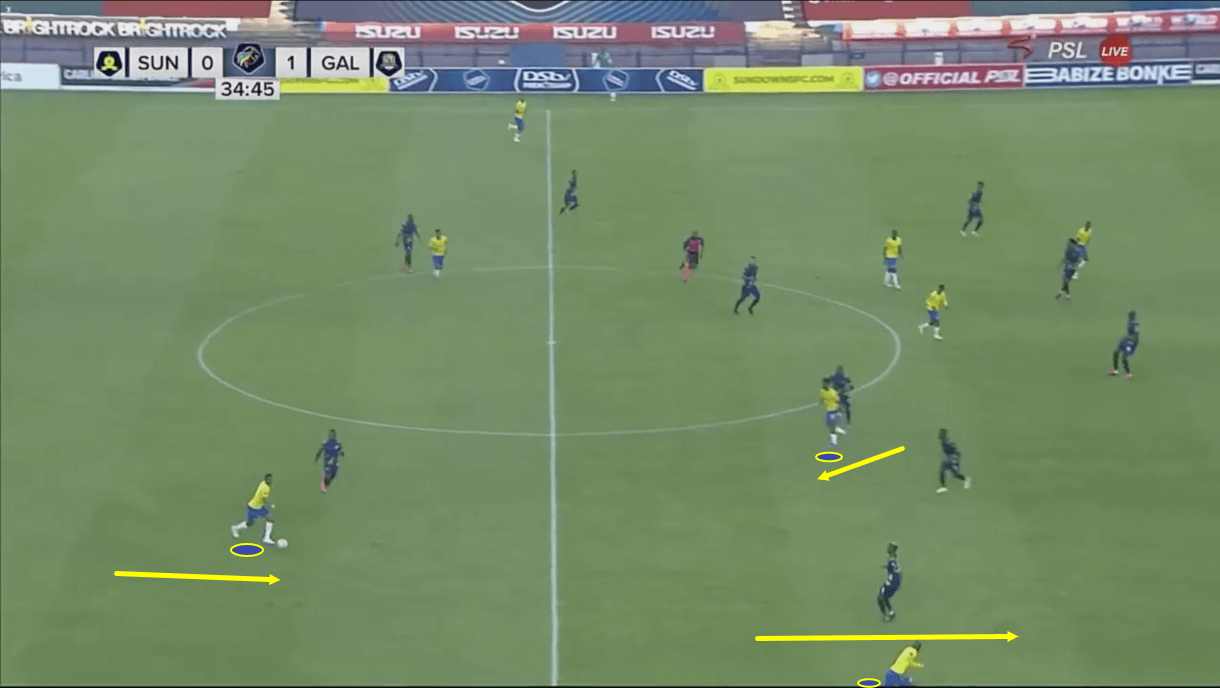
We see another example of the aggressive attacking role that Sundowns’ full-backs play in figures 5-6.
In Figure 5, we see Sundowns in the progression phase, with the right centre-back on the ball, looking to carry the ball beyond the first line of pressure.
As the right central midfielder drops to provide the centre-back with a central passing option, attracting pressure from the opposition’s midfielders in the process, the right-back intelligently bursts forward to exploit space behind the midfield, which opens up more and more as the central midfielder drops and attracts pressure in the deeper area.
Sundowns exploit this space with the centre-back sending a lofted through ball into the right-back’s path, setting the overlapping wide man off into space behind the opposition’s midfield and outside their backline.
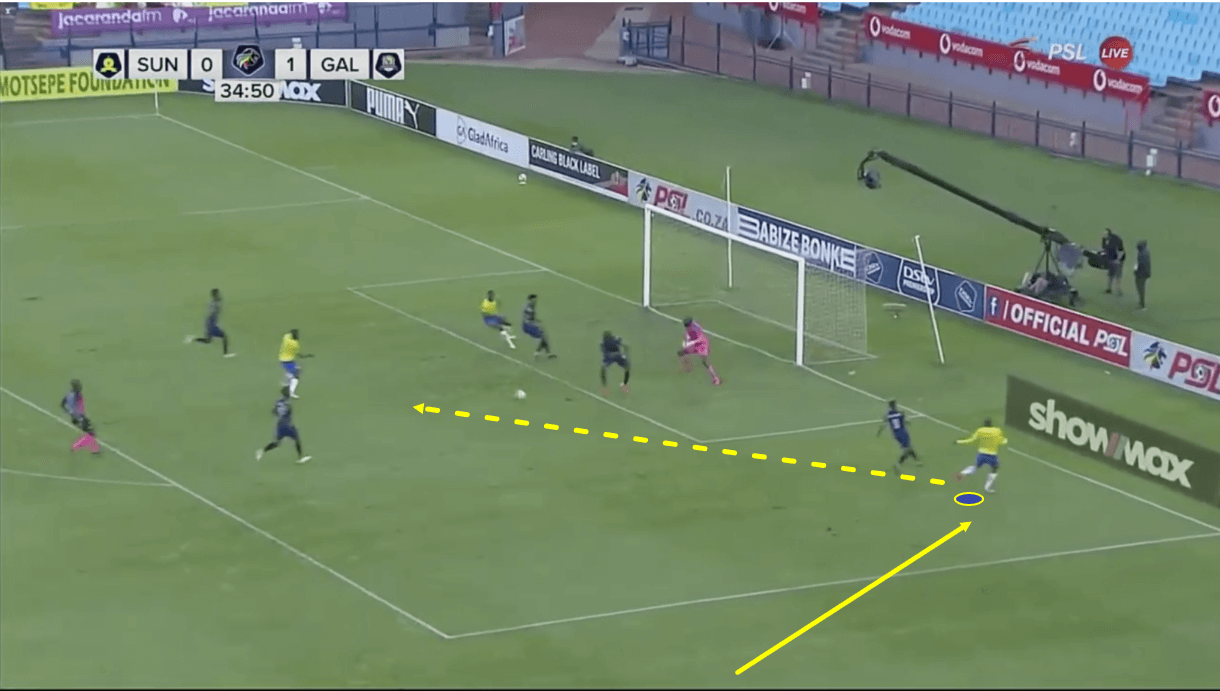
Then, moving on to Figure 6, we see how, as a result of this simple bit of movement, vision, and a well-executed pass, the right-back was able to drive all the way into the opposition’s box, getting towards the byline and pulling a cutback cross into a dangerous position inside the opposition’s penalty area.
If Sundowns’ full-backs get into these positions and play such threatening passes into the danger zone, it will inevitably result in very high-quality goalscoring chances.
This is the kind of position Sundowns like to try and get their aggressive width providers into often, with the widemen looking to create opportunities off the cutback cross, as we see in this example.
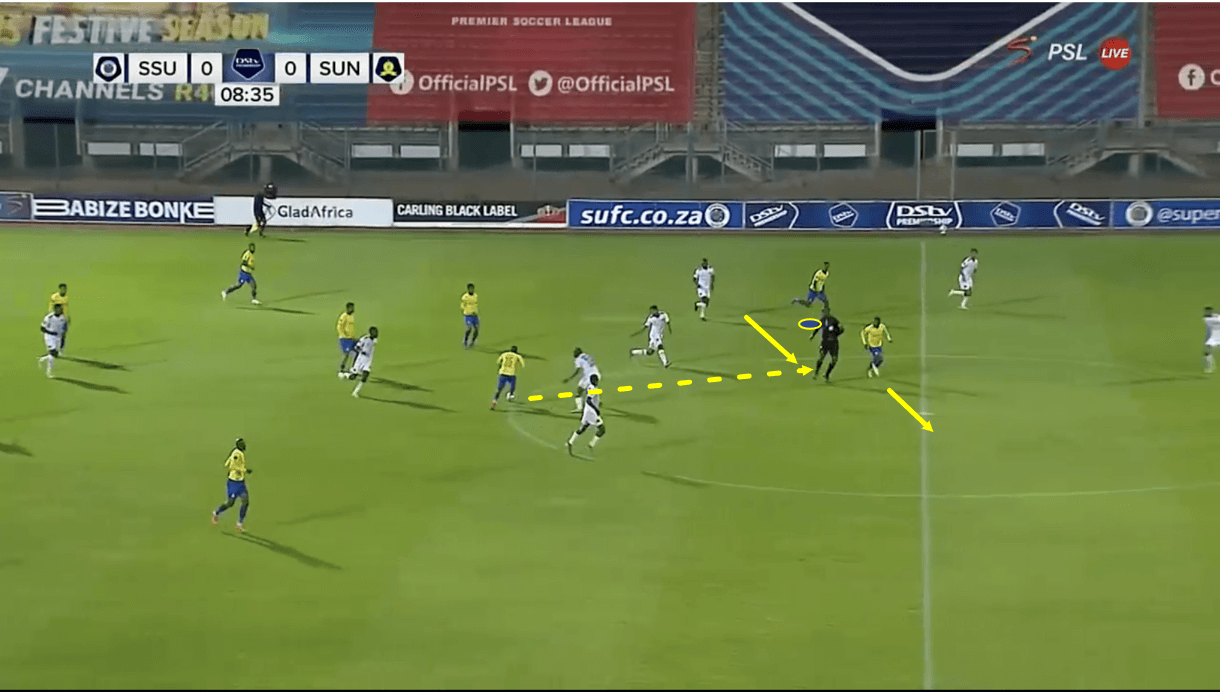
While the aggressive full-backs have a heavy presence in the final third and generally act as the primary crossers in the side, Sundowns’ wingers are typically the primary overall playmaking forces in the side, with the brilliant Themba Zwane, in particular, acting as an elite creator for the South African champions.
Figure 7 shows an example of Zwane drifting into space behind the opposition’s midfield line while providing the deeper midfielder with a progressive, line-splitting pass option.
Zwane’s ability to find space and make himself available for such passes is a quality that can’t be underrated for a side like Sundowns that looks to progress quickly and efficiently via vertical short passes.
While the holding midfielders’ vision and passing quality are essential for achieving successful progression, they only play half of the role.
They also need good movement ahead of them to make the progress happen, and nobody better than Zwane can provide options.
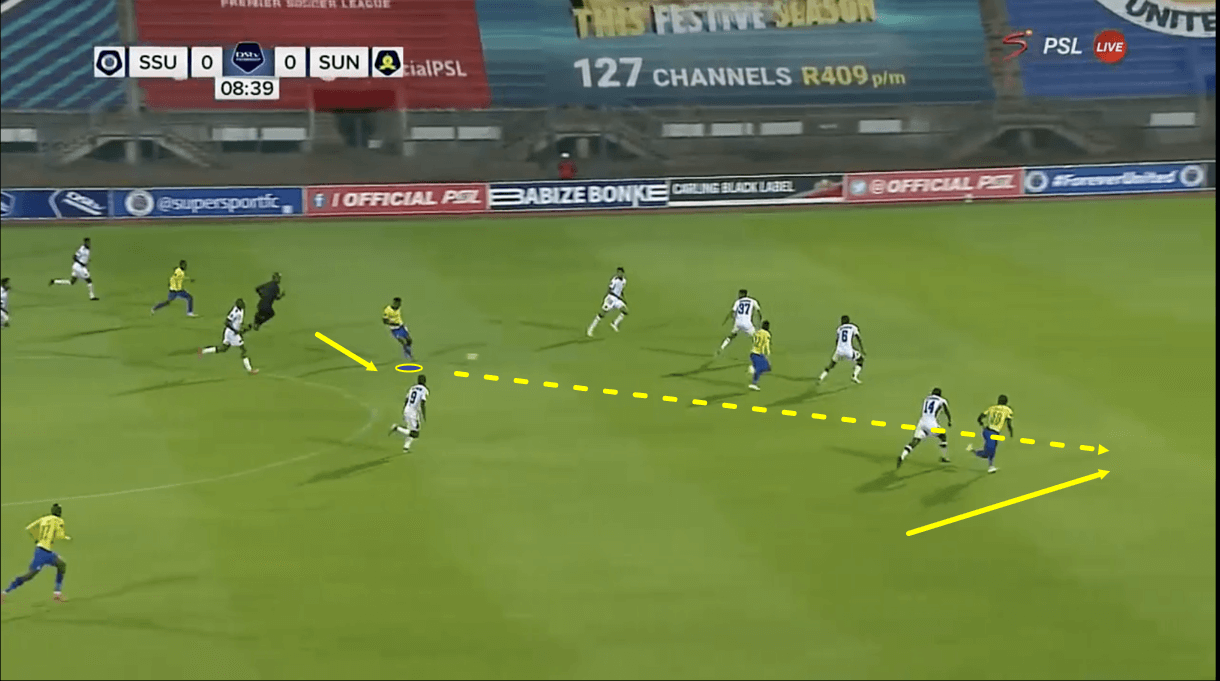
In this example, as we move on into figure 8, we see that Zwane received the ball well in behind the opposition’s midfield, carried it a couple of steps into a more threatening central area and then sent a defence-splitting through ball into the path of the right centre-forward, who’s managed to get beyond the opposition’s backline with a well-timed run to take advantage of Zwane’s well-weighted, defence-splitting through pass.
Again, the passer plays half the role here, as good movement from the strikers is also crucial for making the final third entry happen.
Here, as Zwane and the striker combine, Sundowns create a top-quality goalscoring opportunity, highlighting Zwane’s ability as a creator, as well as some great movement from the forwards ahead of him.
In terms of creative passing behind the forward line and comfortability operating in tight spaces both as a pass receiver, dribbler, passer, and ball carrier, Zwane is very much a key figure in this possession-heavy and technically proficient Sundowns side; he’s excellent at creating chances via off-the-ball movement, passes, and dribbles.
Counter-pressing
As I touched on previously, by keeping a narrow shape with bodies close together when building up and attacking, Sundowns also naturally have a compact shape with lots of bodies around the opposition ball carrier, ready to press after they’ve dispossessed a Sundowns player.
Counter-pressing is an important part of The Brazilians’ game both in terms of keeping goals out at their end and also in an attacking sense.
It helps them shut down opposition counter-attacks quickly before they really get going.
They also create great goalscoring opportunities by launching a counter-attack of their own from an advanced position against a more disorganised opposition defence than they’d be facing in a typical attack.
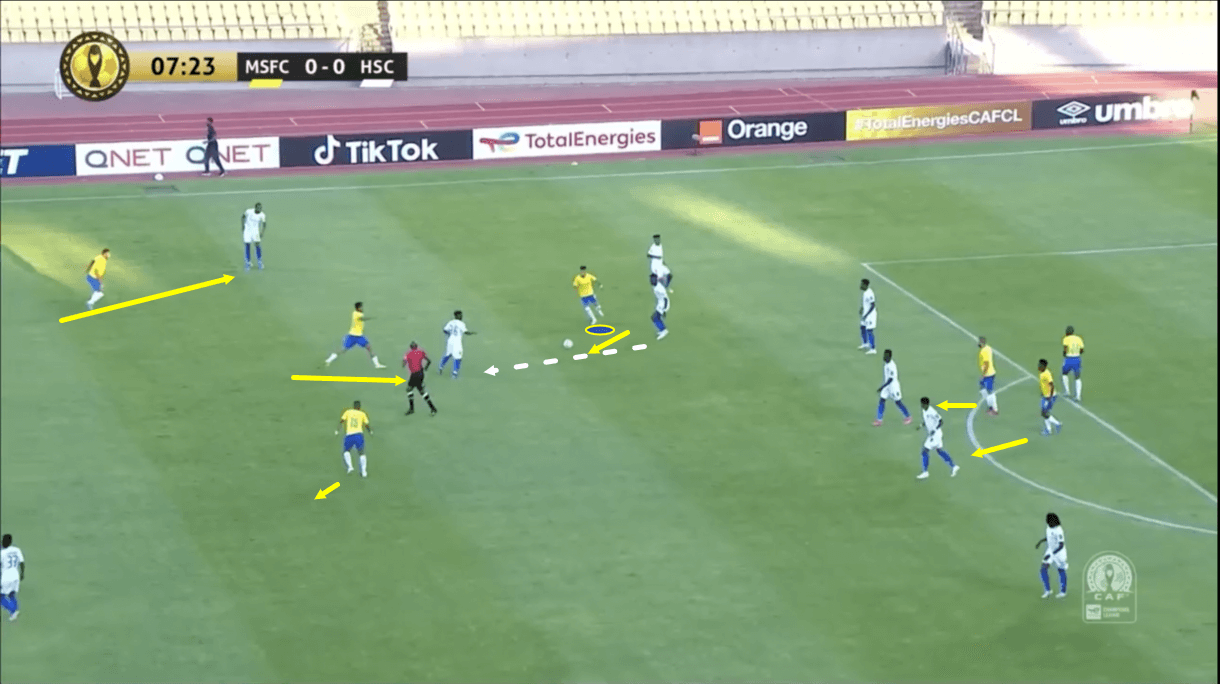
Take figures 9-11, for example.
Just before Figure 9 here, the Sundowns player circled in the left half-space was dispossessed.
After taking the ball back from the Sundowns dribbler, the opposition started trying to build a counter-attack of their own, immediately sending the ball into midfield.
Right away, as the opposition plays the ball into the midfielder, a Sundowns player is close enough to be closing him down aggressively from behind.
The man who was just dispossessed immediately turns his attention to winning the ball back for his side, too, closing down the pass receiver from the other direction while keeping a couple of deep passing options in his cover shadow.
In this image, we can see how Sundowns’ more advanced forwards also start tracking back at this moment, getting tight to some other more central deep passing options, which makes them risky and unattractive for the pass receiver here.
In the meantime, the Brazilians’ left-back starts to access the opposition’s right-winger, again making this passing option less attractive.
We can see the opposition right-back drifting out to the wing and out of the winger’s cover shadow in Figure 9, making himself a viable passing option for the midfielder — and the option that the receiver here eventually takes while under pressure from a couple of Sundowns players.
The right-back receives in more space than the other potential passing options that the midfielder had here, but in a low-value area deep and close to the sideline, which makes him a prime pressing target for Sundowns to get more aggressive with their defending.
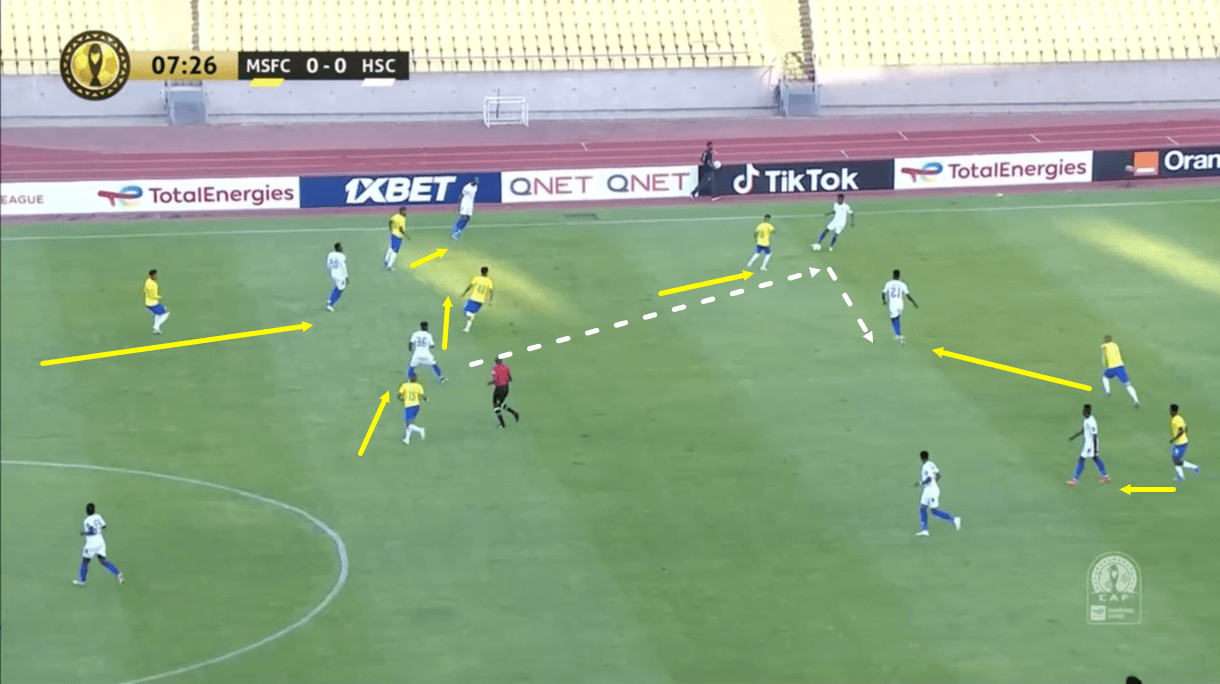
As play moves on into Figure 10, we see how Sundowns’ left-winger, who was initially dispossessed, which led to this passage of play, turns and charges down the right-back on receiving the ball while keeping the midfielder who passed to him in his cover shadow.
The left back has gotten tighter to the opposition’s right winger, and Sundowns’ holding midfield duo has also moved to this side of the pitch to congest space and cut off all potential passing options.
Sundowns’ left centre-back—the deepest yellow shirt in figure 10—has also advanced to get access to the opposition attacker dropping into their inside right channel.
This highlights an important aspect of the Brazilians’ counter-press: the ball-near centre-back retains the freedom to advance into the opposition’s half to get tight to a potential progressive passing option if one appears to be available.
In this regard, the centre-backs are often extremely aggressive in this counter-pressing system, with Sundowns aiming to prevent the man on the ball from enjoying any time or space on the ball and cut off all viable short passing options.
By cutting off the potential shot-passing options and aggressively pursuing the ball carrier, Sundowns aim to stifle the ball progression via short passes while also making it too difficult for the ball carrier to play a good long ball into the vacant space behind Sundowns’ backline, which could be exploited by the aggressive centre-back.
Lastly, it’s worth noting that as the opposition’s right central midfielder goes out towards the under-pressure right-back to try and relieve some of the pressure by giving him a viable short passing option, a Sundowns forward follows him.
This is the passing option that the opposition right-back ultimately takes, and we see the result of playing this pass to a midfielder under aggressive pressure from behind as play moves on into figure 11.
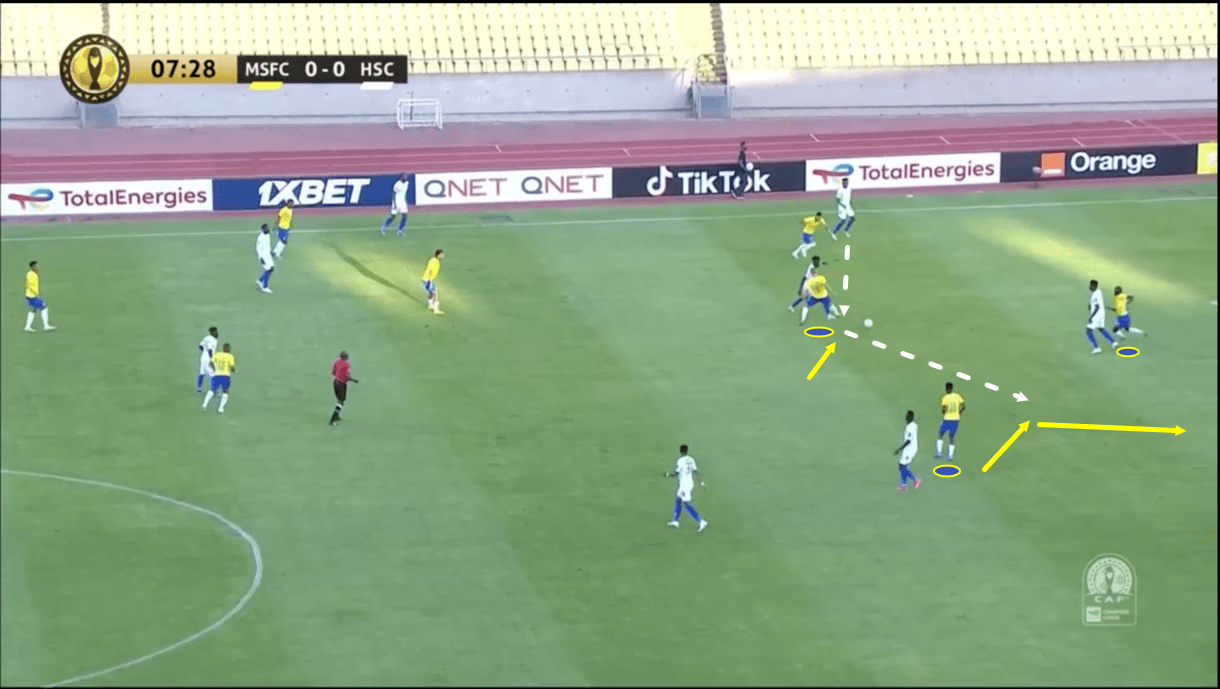
As Figure 11 shows, after the pass was played, by the time the ball reached the right central midfielder, the pressing Sundowns man was right on his tail, preventing him from turning and forcing him into a rushed, poor decision.
The midfielder was pressed into passing the ball back to one of the centre-backs, but the rushed pass was executed poorly, which allowed Sundowns’ right-winger — occupying a more traditional ‘number 10’ position here while marking the opposition’s left central midfielder — to pounce onto the loose ball, carry it beyond the opposition defence and progress into a very threatening goalscoring position.
So, this passage of play highlights the key points of note with regard to Sundowns’ counter-pressing tactics, as well as providing an example both of how their counter-pressing can successfully prevent the opposition from counter-attacking them, as well as how it can create high-quality goalscoring opportunities for Sundowns in the process by pressing opposition players into poor passes or heavy touches that can then be capitalised on by the hounds leading The Brazilians’ aggressive press from the front.
High press
My fourth and final section of analysis within this tactical analysis piece on South Africa’s most dominant team focuses on their high press — another key aspect of their defensive solidity.
Sundowns are generally very aggressive in pressing from the front, during the high-block phase.
This high press, combined with their aggressive and well-organised counter-press, has seen them generate the lowest PPDA (7.42) of any PSL side in 2021/22 thus far.
This essentially indicates that Sundowns have had the most aggressive press in South Africa’s top-flight this term—a further testament to how important aggressive defending is to them and their success.
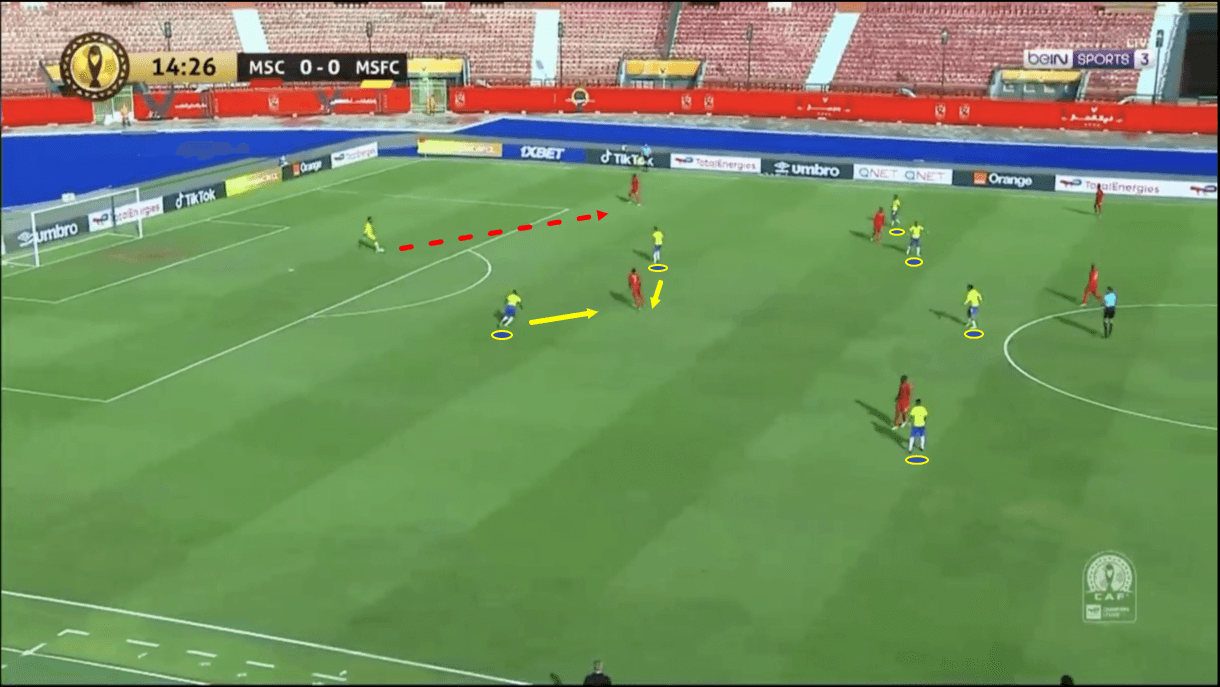
While Sundowns’ shape becomes more of a 4-2-2-2 when in possession, they tend to shape up in more of a traditional 4-4-2 without the ball, as figure 12 indicates.
Here, we see Sundowns defending as they typically do initially during the high-block phase, with both strikers remaining relatively close to the opposition’s deepest midfielder(s), while ensuring they block the passing lanes into this player from the centre-backs.
By positioning themselves like this, they guard against the ball being played into this midfielder from either the goalkeeper or the centre-backs.
Meanwhile, The Brazilians’ midfield line behind the two strikers generally gets very horizontally compact, allowing little space to form between the midfielders, as we also see in figure 12.
The goal of Sundowns’ defensive tactics here is to prevent the opposition from finding any way through the centre of the pitch, thus forcing them into a wider area, which they’ll use as a pressing trigger — meaning the intensity of their press increases as the ball is played out wide.
Here, we see how Sundowns’ players react to the ball being played out wide to the left centre-back from the goalkeeper.
The ball-near forward closes down the receiver while keeping the holding midfielder in his cover shadow.
At the same time, the ball-far forward moves over to get tighter to the holding midfielder from behind while also closing the distance between him and the goalkeeper should the opposition centre-back look to send the ball straight back to him.
The ball-near winger gets higher and wider while the rest of the midfield quartet also shifts over to retain a compact shape with little distance between the players and ensure the centre remains protected.
Similar to when counter-pressing, Sundowns’ press here focuses on congesting space around the ball and making it difficult for the man on the ball to 1.
Find short passing options and 2.
Create enough space to play a longer pass that could exploit, for instance, the evident space now opening on the opposite wing.
This would be a weakness in Sundowns’ defence but thanks to the organisation and aggressiveness of their press, they’re generally good at preventing the switch from happening.
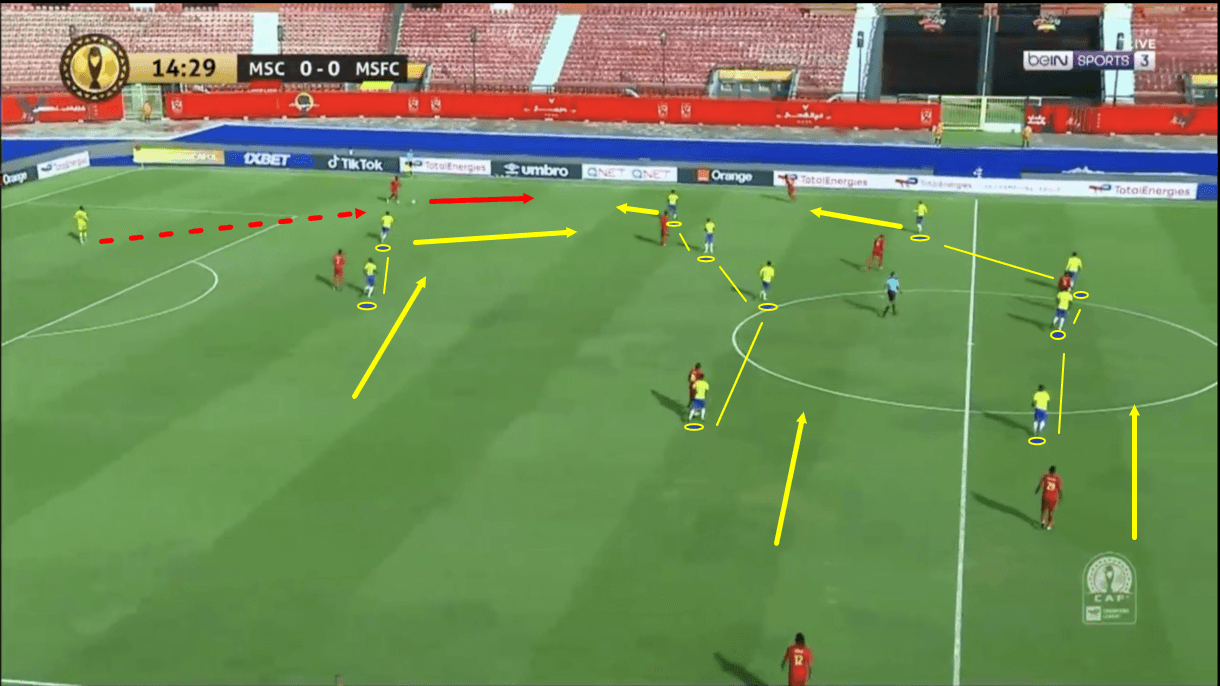
As play moves on into Figure 13 and the opposition’s left centre-back begins carrying the ball forward, we see a clearer image of how Sundowns’ shape has shifted to a heavy focus on cramming all the space around and in front of the ball carrier on this wing while still retaining an overload in midfield at the expense of offering any coverage at all on the ball-far wing.
The ball-near full-back pushes up to keep a close link between him and the aggressive ball-near winger, similar to how the ball-near central midfielder operates here.
As the opposition ball carrier begins to move forward, the ball-near winger pushes out to close him down while blocking the passing lane into the left back, who we see providing the width for his side on their left wing.
As a result of this movement, the ball-near central midfielder must take up marking duty on the opposition’s ball-near central midfielder — a role he performs well and seamlessly thanks to his close proximity to the winger.
So, we see from this little example how the compact nature of Sundowns’ aggressive high press helps them to adequately cover the opposition’s short passing options.
Additionally, in Figure 13, we see how the ball-far centre-forward has now assumed marking duty on the holding midfielder, with the ball-near forward now aggressively pursuing the ball carrier.
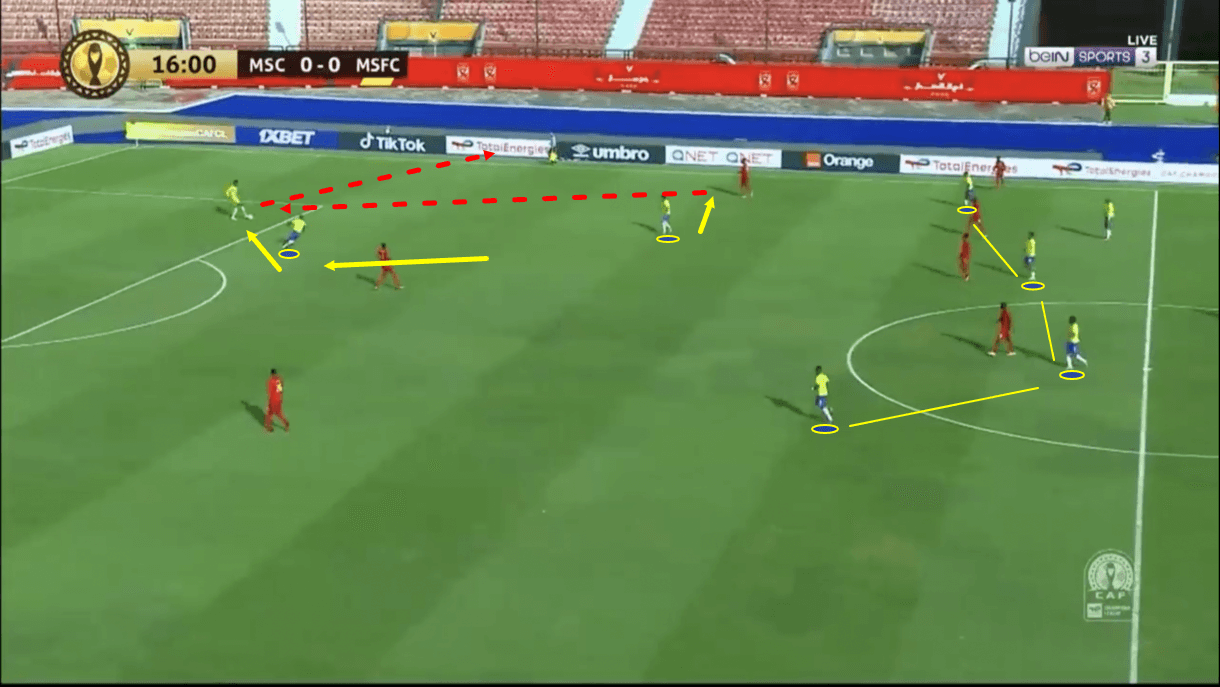
By making all potential passing options unattractive yet again while applying increased pressure on the ball carrier, Sundowns once again forced the ball carrier into a rushed move.
As play progresses into Figure 14, we see that the left centre-back was ultimately pushed into playing the backward pass to the goalkeeper that the ball-far centre-forward had been patiently biding his time and waiting for.
As the backwards pass is played, the right striker continues marking the left centre-back while Sundowns’ left striker begins closing down the ‘keeper, of course, while bending his run intelligently to keep the holding midfielder in his cover shadow and guard against the possibility of the ‘keeper shifting the ball onto his right side and pulling off a potentially devastating switch of play.
The right striker’s press was executed perfectly while also being aggressive in closing down the goalkeeper.
This led to the ‘keeper being rushed into a decision, and he opted for safety-first on this occasion, simply booting the ball out of play to relinquish possession and a throw-in to Sundowns in what is an advanced and potentially threatening area of the pitch for the Pretoria-based side.
Even though the shape is different, many of the principles that were evident in Sundowns’ aggressive and successful counter-pressing are also evident in their performance in the high block here.
They focus on keeping a horizontally compact shape, congetting space around the ball carrier, preventing short passes, packing the centre, and forcing the ball into wide areas from where an aggressive press will be deployed.
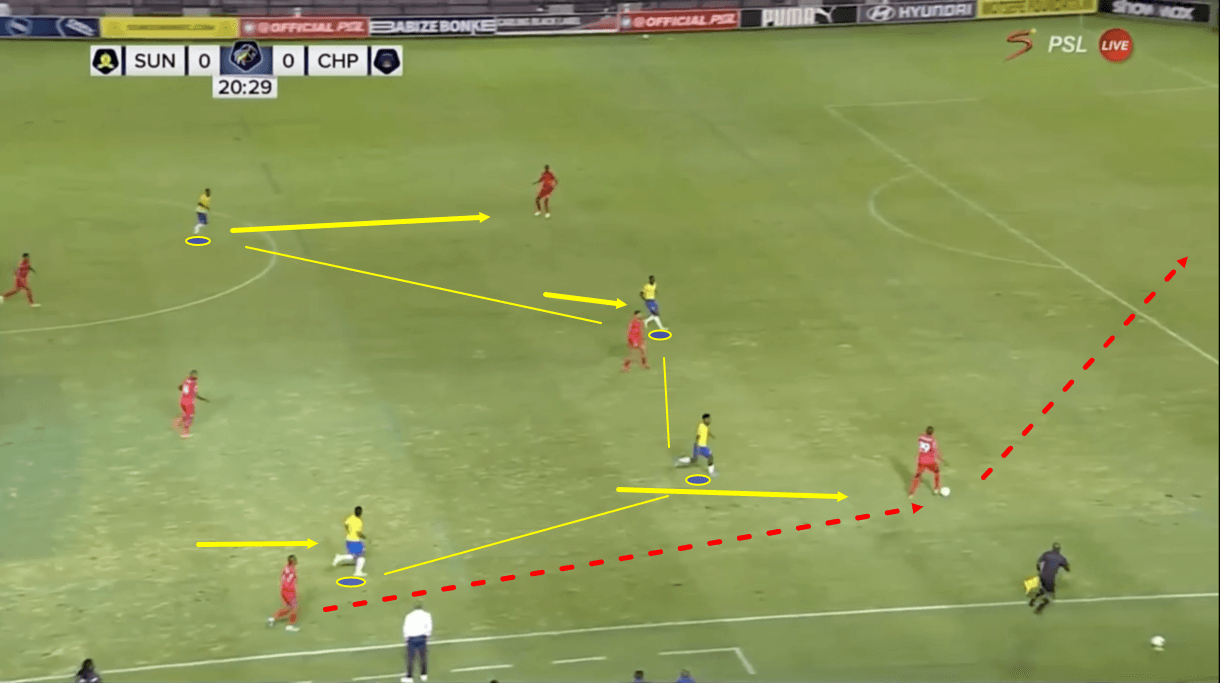
As the ball is played out into wide areas, it’s common to see Sundowns’ press increase in intensity as the ball is played backwards, which we also saw a glimpse of in Figure 14.
We see this again in Figure 15.
Here, with short passing options again cut off and aggressive pressure being applied by The Brazilians’ right-winger, the opposition’s left-back was forced into sending the ball back to the left centre-back.
Again, thanks to Sundowns’ organized, compact shape and focus on cutting off the near passing options while congested space around the ball carrier, the left centre-back was forced backward, with the pressure coming from Sundowns’ right striker this time.
Again, the pressing angle is so important here.
If Sundowns’ forward presses mindlessly without cutting off the passing lane into midfield, then the opposition will have a clear opportunity to play into their press and progress through midfield.
However, the forward gets his pressing angle spot on and succeeds in cutting off the passing lane while closing down the ball carrier to force him backwards.
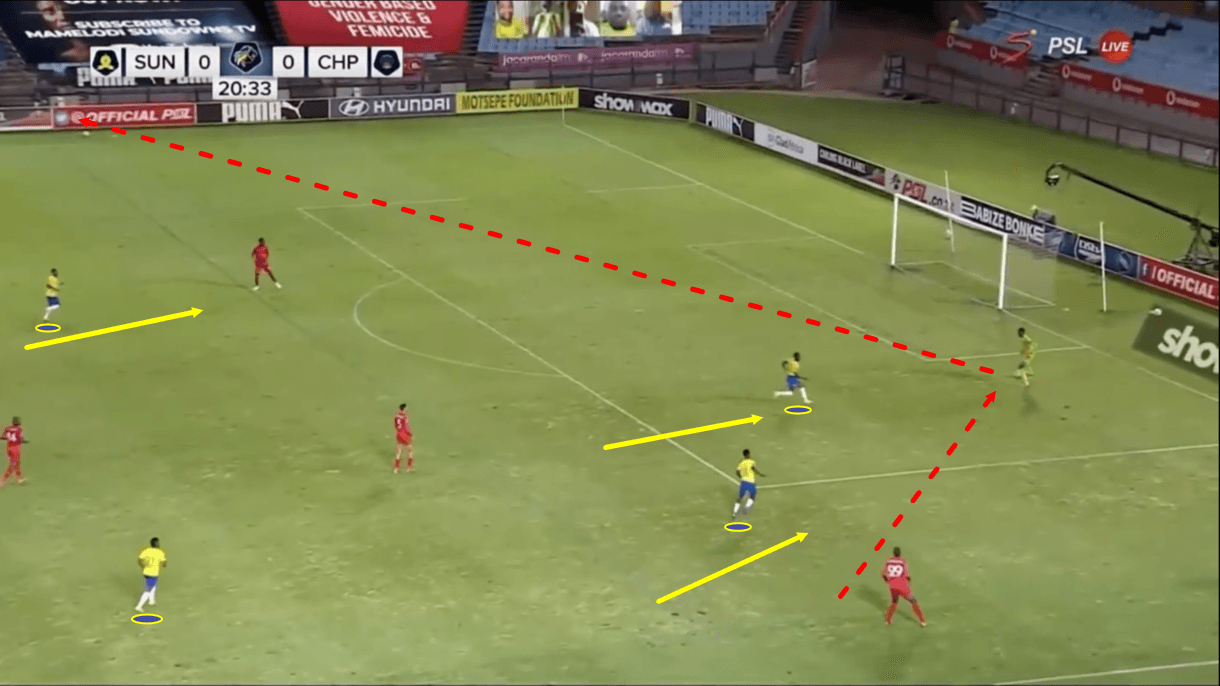
As we move on into Figure 16, we see how after the ball is played back to the goalkeeper, the pressure now comes from Sundowns’ left striker, who again perfects the angle of his press while aggressively closing down the keeper.
With the near-passing options also under plenty of pressure and the keeper not afforded enough space to launch a long ball forward, again, we see Sundowns end the opposition’s attack here, with the goalkeeper opting to send the ball out for a throw-in.
These examples show how aggressiveness, organisation, a compact shape and intelligent pressing are key to Sundowns’ defensive tactics and the successful realisation of Sundowns’ playing principles.
Conclusion
To conclude this tactical analysis, Sundowns tick many of the boxes that football fans would look for in a conventionally attractive modern football team in terms of how they approach the game with and without the ball.
They are possession-based yet vertical and aggressive when they’ve forged openings to play through the lines.
They are excellent at getting exciting creators into space between the lines, which leads to plenty of high-quality chances and, ultimately, plenty of goals.
Meanwhile, without the ball, Sundowns are highly aggressive, both in terms of their counter-press and their high-pressing tactics.
They focus on congetting space around the opposition ball carrier, maintaining a horizontally compact shape, protecting the centre, and ensuring links between players aren’t broken when the more advanced player opts to move more aggressively.
As we’ve analysed, this helps them to successfully kill opposition attacks before they really get going on occasion, thanks to their players’ intelligent and extremely aggressive pressing.
There’s a lot to like about this Sundowns team as a neutral, and it’s well worth catching some of their games in 2021/22 if you’re not already planning to do so.

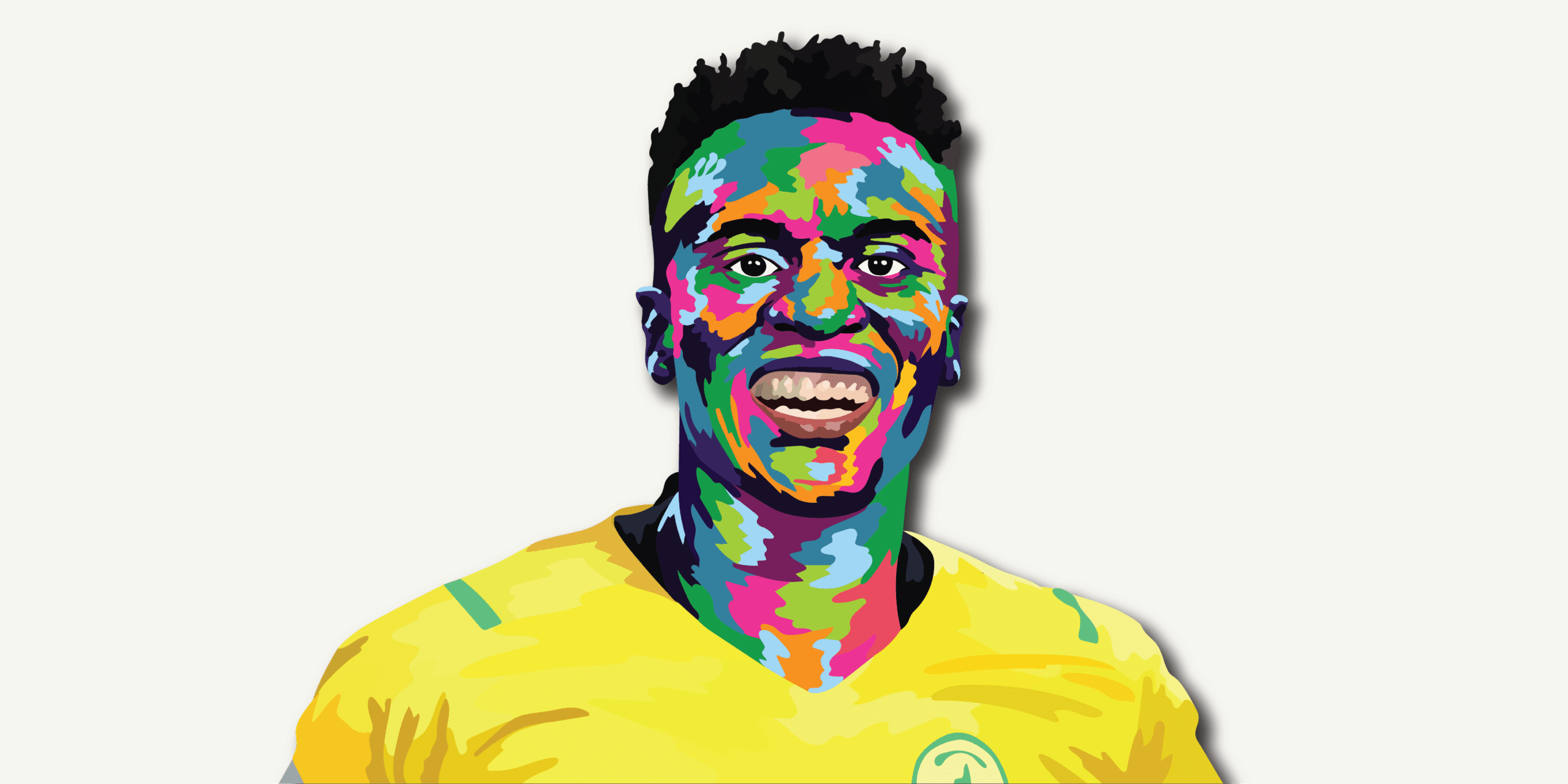



Comments